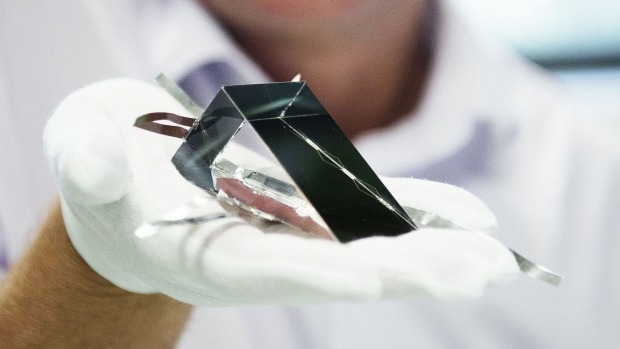Researchers at the University of New South Wales (UNSW) have utilized the light-trapping effects of a basic prism to boost the efficiency of solar cells. The prism could help make solar panels cheaper and more efficient, and it’s already broken a world record for the amount of solar energy it can create from unfocused sunlight (the sort of sun that hits our roofs).

Image source: UNSW.
Built by Dr. Mark Keevers and Professor Martin Green, the mini-module converts 34.5% of received solar energy into electricity. The result, confirmed by the US National Renewable Energy Laboratory, has eclipsed the 24% efficiency achieved by an 800-square-centimeter commercial module made by Alta Devices in the US. The UNSW module is 28 square centimeters, and the typical efficiency for commercially available solar panels is 14 to 22%.
Although other cells have obtained higher efficiencies from unfocused sunlight, these results were achieved before being placed into prototypes or modules that could be scaled up for commercial use.
So how does the record-breaking device work? First, it splits sunlight into four bands. Inside the prism, solar cells use a type of semiconductor material, such as silicon, to convert a particular band of sunlight into electricity. The prism also uses high-purity glass and a special filter to help steer the sunlight so that (most of) it stays trapped inside, eliminating wastage.

Image source: UNSW.
“Right now, this is a proof of concept prototype,” Keevers told Mashable . “Of course, it's expensive and we've used expensive materials and techniques.” The mini-module cost roughly $3,000 to create, which according to Keevers, was normal for a lab experiment.
When costs are reduced, such prisms could be installed on a larger scale for rooftop use. “Instead of what you can get now, which is typically, say, 17% [efficiency] modules for your rooftops, in 10 or 20 years, you might be able to buy 34% efficient modules, so you'd need half as many for a rooftop to get the same electricity out,” Keevers said.
The team will soon be pursuing higher rates of efficiency, along with lower costs. According to Keevers, the aim was to lower the cost of solar energy to parity or under that of coal to allow a transition to an economy based on renewables.
Advertisement
Learn more about Electronic Products Magazine





